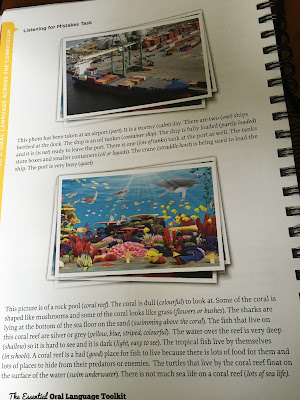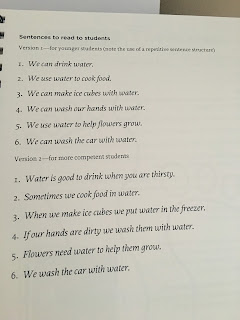The Essential Oral Language Toolkit by Jane Van Der Zeyden
Great Activities for Oral Language
- Think about this example;
- "The ground is wet. The sun is slowly drying the puddles up'.
- Now think of some other ways we could say the same thing eg,
- 'The ground is wet and the sun is lowly drying the puddles up'.
- 'The puddles on the wet ground are slowly drying up because of the sun'.
- "Due to evaporation, the puddles are slowly drying up.'
- 'Although the ground is wet, the puddles are slowly drying up'.
- 'Evaporation is causing the puddles on the wet ground to dry up'.
Questions for Self:
- Do I deliberately model the use of new and unfamiliar vocabulary?
- Do I deliberately model the use of new language forms and structures? How and when do I do it?
- How do I use oral language tasks to introduce and model the new language as well as develop thinking?
Vocab Activities
- bingo with words on a card for each child
- Stretching sentences - select a key word then students suggest other words to construct sentences -
- Twenty Questions
- Talking Pictures - describe picture whilst sts point to each part. Then sts do it in pair
Oral Language across the Curriculum - Activities
- Same and Different - work in pairs; 'My picture is the same as yours because ..' ' One similarity I notice is ... ' 'My picture is different to yours because ... ' 'One difference I notice is ...'
- Opinion Continuums - give a topic and sts decide where they stand on the issue
- Disappearing Definition (fading)
- Round the Board Game ... move round a game board upon landing pick up a card and decide true or false. Move counter forward or back 1/2 squares (as decided) according to if answer is correct or not.
- Barrier Games
- Listening for Mistakes - show sts a picture which you are going to read about and say if they hear any mistakes they have to let you know. Give them a talking frame ... 'Excuse me, you said ... but ...'
Oral Language and Reading
- Anticipatory Guides - write approximately 6 statements focusing on the main messages of the text including both true and false statements. Sts read statements before the text. After reading text allow sts to change answers if they need to. Discuss. Anticipatory Guide Template
- Say It! - create a grid of 9/12 squares, and write a simple structured role play based on the topic/book. Sts throw dice to work out co-ordinates and the st carries out the short role play.
- 3 Level Guides
- What Am I Thinking? - Character from the book with a speech bubble. Sts write down what they think the character is saying or thinking at a particular time
- Tell the Story - sts have objects/pictures from the text and order and retell
- Sequencing - sequence the text
Oral Language and Writing Activities
- Dictogloss - sts jot down notes whilst text is being read and then in pairs/groups reconstruct the text, You might choose to provide a writing frame (first few letters of each sentence)
- Running Dictation - place parts of text around room, the runner needs to read text and then run back to tell the group
- Listening grids:
- Skills Flow -sts have a series of photos, they label each picture as you read out sentences from a text (sentence 1 = picture 1), sts then retell the story using the pictures, sts then write sentences under the pictures
- text reconstruction
Digital Oral Language Activities
- Bus Stop - place devices around the room set up to play short videos, sts jot down the main idea about each
- Template - give each st a template to write on as they watch a video
skdkDljslklsakdjlksdl







